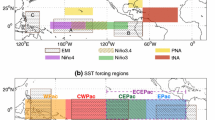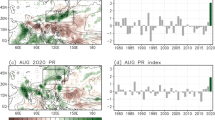Abstract
Extreme summers of Europe are usually affected by blocking highs that shift between Western and Eastern Europe to cause regional variations in the surface temperature anomalies. Generally, the blocking high induces a regional temperature dipole with poles of warm and cold anomalies on two sides of Europe. The extreme summers of Western Europe, when the Eastern Europe is colder than normal, are usually associated with the teleconnections arising from positive Indian Ocean Dipole (IOD) events. In contrast, analogous warm events in Eastern Europe are usually associated with La Niña. The western Pacific conditions that prevail during the turnaround phase of El Niño to La Niña are found to be responsible for developing the extreme Eastern Europe events. The role of North Atlantic Oscillation (NAO) is not blatant for the Eastern Europe summers though it has a weaker influence on Western Europe summers for which IOD plays a dominant role: The seasonal July–August correlation for Western Europe temperature with IOD index is higher than that with the NAO index. The teleconnections for both types of extremes are associated with a Rossby wavetrain that travel around the globe to reach the Europe. This circumglobal teleconnection is largely determined by the location of the tropospheric heat source. For Western Europe warm events, major contributions come from the atmospheric convections/diabatic heating over northwest India and southern Pakistan. For the Eastern Europe events, the convections over northwest Pacific, south of Japan, are found to project the signals on to the mid-latitude wave-guide. These patterns of teleconnection are so robust that those can be seen on daily to seasonal time-scales of atmospheric anomalies. The wavetrains are found to set-in a couple of weeks prior to the development of blocking highs and extreme hot conditions over Europe.











Similar content being viewed by others
References
Barriopedro D, Fischer EM, Luterbacher J, Trigo R, Garcia-Herrera R (2011) The hot summer of 2010: redrawing the temperature record map of Europe. Science 332(6026):220–224. doi:10.1126/science.1201224
Behera SK, Krishnan R, Yamagata T (1999) Unusual ocean-atmosphere conditions in the tropical Indian Ocean during 1994. Geophys Res Lett 26:3001–3004
Beniston M (2004) The 2003 heat wave in Europe: a shape of things to come? Geophys Res Lett 31:L02202
Black E, Sutton R (2007) The influence of oceanic conditions on the European summer of 2003. Clim Dyn 28:53–66
Black E, Blackburn M, Harrison G, Hoskins BJ, Methven J (2004) Factors contributing to the summer 2003 European heatwave. Weather 59(8):217–223
Cassou C, Terray L, Phillips AS (2005) Tropical Atlantic influence on European heat waves. J Clim 18:2805–2811
Ding Q, Wang B (2005) Circumglobal teleconnection in the Northern Hemisphere summer. J Clim 18:3483–3505
Ding Q, Wang B, Wallace JM, Branstator G (2011) Tropical-extratropical teleconnections in Boreal summer: observed interannual variability. J Clim 24:1878–1896
Dole R, Hoerling M, Perlwitz J, Eischeid J, Pegion P, Zhang T, Quan X-W, Xu T, Murray D (2011) Was there a basis for anticipating the 2010 Russian heat wave? Geophys Res Lett 38:L06702. doi:10.1029/2010GL046582
Farnaz P, Tozuka T, Jahanbakhsh S, Sarraf BS, Ghaemi H, Yamagata T (2012) The interannual precipitation variability in the southern part of Iran as linked to large-scale climate modes. Clim Dyn. doi:10.1007/s00382-012-1357-5
Ferranti L, Viterbo P (2006) The European summer of 2003: sensitivity to soil water initial conditions. J Clim 19:3659–3680
Feudale L, Shukla J (2007) Role of mediterranean SST in enhancing the European heat wave of summer 2003. Geophys Res Lett. 34. doi:10.1029/2006GL027,991
Feudale L, Shukla J (2010) Influence of sea surface temperature on the European heat wave of 2003 Summer. Part II: a modeling study. Clim Dyn. doi:10.1007/s00382-010-0789-z
Fink AH, Brucher T, Kruger A, Lackebusch GC, Pinto JG, Ulbrich U (2004) The 2003 European summer heatwaves and drought—Synoptic diagnosis and impacts. Weather 59:209–216
Fischer EM, Seneviratne SI, Vidale PL, Luthi D, Schar C (2007) Soil moisture–atmosphere interactions during the 2003 European summer heat wave. J Clim 20:5081–5099
Gilbert N (2010) Russia counts environmental cost of wildfires. Nat News 12. doi:10.1038/news.2010.404
Grazzini F, Viterbo P (2003) Record-breaking warm sea surface temperature of the Mediterranean Sea. ECMWF Newslett 99:2–8
Guan Z, Yamagata T (2003) The unusual summer of 1994 in East Asia : IOD teleconnections. Geophys Res Lett 30. doi:10.1029/2002GL016831
Janowiak JE, Xie P (1999) CAMS_OPI: a global satellite-rain gauge merged product for real-time precipitation monitoring applications. J Clim 12:3335–3342
Jung T, Ferranti L, Tompkins AM (2006) Response to the summer 2003 Mediterranean SST anomalies over Europe and Africa. J Clim 19:5439–5454
Kalnay E et al (1996) The NCEP/NCAR 40 year reanalysis project. Bull Amer Meteor Soc 77:437–471
Lin H (2009) Global extratropical response to diabatic heating variability of the Asian summer monsoon. J Atmos Sci 66:2697–2713
Nakamura M, Enomoto T, Yamane S (2005) A simulation study of 2003 heatwave in Europe. J Earth Sim. es.jamstec.go.jp
Ogi M, Yamazaki K, Tachibana Y (2004) The summertime annular mode in the northern hemisphere and its linkage to the winter mode. J Geophys Res 109:D20 114. doi:10.1029/2004JD004,514
Ogi M, Yamazaki K, Tachibana Y (2005) The summer northern annular mode and abnormal summer weather in 2003. Geophys Res Lett 32. doi:10.1029/2004GL021,528
Rao SA, Yamagata T (2004) Abrupt termination of Indian Ocean Dipole events in response to intraseasonal disturbances. Geophys Res Lett 31:L19306. doi:10.1029/2004GL020842
Reynolds RW, Smith TM, Liu C, Chelton DB, Casey KS, Schlax MG (2007) Daily high-resolution blended analyses for sea surface temperature. J Clim 20:5473–5496
Rodwell MJ, Hoskins BJ (1996) Monsoons and the dynamics of deserts. Q J R Meteor Soc 122:1385–1404
Saji NH, Goswami BN, Vinayachandran PN, Yamagata T (1999) A dipole mode in the tropical Indian Ocean. Nature 401:360–363
Sato N, Takahashi M (2007) Dynamical processes related to the appearance of the Okhotsk high during early midsummer. J Clim 20:4982–4994
Schar C, Vidal PL, Lϋthi D, Frei C, Häberli C, Liniger MA, Appenzeller C (2004) The role of increasing temperature variability in European summer heatwaves. Nature 427:332–336
Simmons AJ, Wallance JM, Branstator GW (1983) Barotropic wave propagation and instability, and atmospheric teleconnection patterns. J Atmos Sci 40:1363–1392
Stott P, Stone DA, Allen M (2004) Human contribution to the European heatwave of 2003. Nature 432:610–614
Vautard R, Honoré C, Beekmann M, Rouil L (2005) Simulation of ozone during the August 2003 heat wave and emission control scenarios. Atmos Environ 39:2957–2967
Yamagata T, Behera SK, Luo J-J, Masson S, Jury MR, Rao SA (2004) Coupled ocean-atmosphere variability in the tropical Indian Ocean. In: Wang C, Xie S-P, Carton JA (eds) AGU Book ocean-atmosphere interaction and climate variability. Geophys Monogr, 147, AGU, Washington DC, pp 189–212
Yang J, Liu Q, Liu Z, Wu L, Huang F (2009) Basin mode of Indian Ocean sea surface temperature and Northern Hemisphere circumglobal teleconnection. Geophys Res Lett 36:L19705. doi:10.1029/2009GL039559
Yasui S, Watanabe M (2010) Forcing processes of the summertime circumglobal teleconnection pattern in a dry AGCM. J Climate 23:2093–2114
Yuan C, Tozuka T, Miyasaka T, Yamagata T (2009) Respective Influences of IOD and ENSO on the Tibetan Snow Cover in Early Winter. Clim Dyn 33:509–520
Acknowledgments
We thank Dr. Q-H Ding and an anonymous reviewer for their constructive suggestions that helped to improve the quality of the manuscript.
Author information
Authors and Affiliations
Corresponding author
Rights and permissions
About this article
Cite this article
Behera, S., Ratnam, J.V., Masumoto, Y. et al. Origin of extreme summers in Europe: the Indo-Pacific connection. Clim Dyn 41, 663–676 (2013). https://doi.org/10.1007/s00382-012-1524-8
Received:
Accepted:
Published:
Issue Date:
DOI: https://doi.org/10.1007/s00382-012-1524-8




